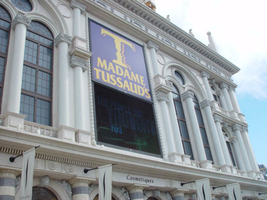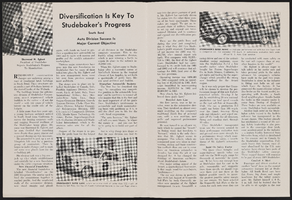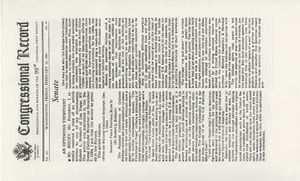Search the Special Collections and Archives Portal
Search Results

Transcript of interview with Harry Sax by Barbara Tabach, April 8, 2015
Date
Archival Collection
Description
Interview with Harry Sax by Barbara Tabach on April 8, 2015. In this interview, Sax discusses his family history and upbringing in Chicago, and his military service in Munich. He returned to Chicago and became business partners with Michael Schulson, with whom he opened several Arby's outposts, and expanded to Las Vegas in 1968. He talks about life in Las Vegas in the 1970s and the competition in the fast food industry. He then talks about the reform congregation in Chicago and his connection to Judaism throughout his life. He describes himself as a "closet Jew" before becoming president at Congregation Ner Tamid in 2007. Sax discusses the programs at Ner Tamid for all ages, and his continued involvement in the community.
In 1939, Harry Sax was born in Chicago, Illinois, the son to first generation American Jews. He spent his childhood on Chicago's South, where his family belonged to a progressive Reform congregation. After graduating from Hyde Park High School, he continued his education at Indiana University. In college, Harry was a member of the ZBT Jewish fraternity, participated in a singing group, and was a cadet in the Reserve Officers' Training Corps. Upon graduating from college, Harry was stationed in Munich, Germany as a second lieutenant in the Quartermasters Corps. In addition to his required military duties, he also participated in an after-hours acting group; through this group, he was hired as an extra and for small roles, including The Great Escape. When he finished his service, Harry returned to Chicago, where he connected with a high school friend, Mike Schulson. The two became partners and purchased Arby's franchises in Chicago and Las Vegas. Thus, in 1968, while his partner remained in Chicago, Harry moved to Las Vegas and opened two franchise locations in two weeks. Though it took a few years to stabilize the business and overcome competition, he opened a third location in 1972 on South Decatur, what was then the western edge of the city. Today, Harry has nineteen locations in Las Vegas, with additional franchises in Reno and Barstow, California, and employs nearly 300 people. After about twenty years as a "closet Jew" in the city, Harry reconnected with Judaism and joined Congregation Ner Tamid in the late 1990s. He served on its board, eventually becoming vice president and then president (2007-09). He also dedicated himself to have a bar mitzvah, following up on his Jewish education and confirmation as a teenager. Harry has also served on the Anti-Defamation League's board as well as an active member of the Chamber of Commerce.
Text
Tropicana Hotel and Casino Records
Identifier
Abstract
The Tropicana Hotel and Casino Records (1956-2024) contain operational records, promotional material, architectural drawings, and audiovisual recordings related to the hotel/casino general operations.
Archival Collection
Lee Cagley oral history interview
Identifier
Abstract
Oral history interview with Lee Cagley conducted by Stefani Evans and Claytee White on August 08, 2016 for the Building Las Vegas Oral History Project. Cagley discusses the importance of keeping the various pieces of the infrastructure of a resort invisible in order to maximize the visitor experience. He also describes the challenges the Las Vegas, Nevada resort industry finds in creating the best visitor experience for multiple generations at the same time.
Archival Collection

"The Movies and the Civil Rights Movement: Some Possible Influences": manuscript draft by Roosevelt Fitzgerald
Date
Archival Collection
Description
From the Roosevelt Fitzgerald Professional Papers (MS-01082) -- Unpublished manuscripts file.
Text

Catherine Cortez Masto oral history interview: transcript
Date
Archival Collection
Description
Oral history interview with Catherine Cortez Masto conducted by Claytee D. White on August 10, 2018 for the Latinx Voices of Southern Nevada Oral History Project. Catherine Cortez Masto grew up in Las Vegas near where the town ended and the desert began, which at that time was near Decatur and Pennwood. She grew up playing in the streets and riding horses and motor bikes with girlfriends and cousins. Her father, Manny Cortez, began as a valet at the Dunes before entering politics. He served 16 years on the County Commission and then 13 years as the chief of the Las Vegas Convention and Visitors Authority. As the head of the LVCVA, Manny oversaw campaigns to increase tourism, enlarge McCarran International Airport, improve taxicab service, and served as a visionary for the entire region. Catherine followed in her father's footsteps while being her own woman and making her own mark on the region. She attended college at UNR and law school at Gonzaga University School of Law. After a clerkship, she worked for a small local Las Vegas firm for 4 - 5 years, then moved to the governor's and then served two terms as Nevada's Attorney General. Currently she's in the US Senate with committee assignments that include Banking, Housing and Urban Affairs; Energy and Natural Resources; Commerce, Science, and Transportation; Rules and Administration; Indian Affairs, and the Committee on Aging. Subjects discussed include: Dunes, Manny Cortez, County Commission, LVCVA, Judge Carl Christensen, Judge Mendoza, Taxi Authority, Tourism, and Mike O'Callaghan.
Text

Photographs of Madame Tussaud's signs, Las Vegas (Nev.), 2002
Date
Archival Collection
Description
Site name: Venetian (Las Vegas, Nev.)
Site address: 3377 S Las Vegas Blvd
Sign details: Madame Tussaud's Wax Museum is located inside the Venetian Hotel and Casino. Located at the southern end of the property, it is tucked away at the end of a long stretch of escalators. Even though it is not in complete plain view, the facility is directly in the line of pedestrian traffic. The escalators serve as one of the main causeways into the Venetian for the traveler headed north on the east side of the strip. The facility is also advertised by an architecturally integrated building sign, and an LED screen that are in plain view from the street. A the end of the bay of escalators, a platform folds out, containing the vibrant entrance to the Wax Museum. Flanking the large opening designated as the entrance, are six free standing sculpted cabinet, advertising for Madame Tussaud's, lining up three on either side of the door. Standing underneath the entry, are a cast of ever rotating wax figures of celebrities. Just beyond the wax sentry, six more sculpted cabinets are present on other side of the pedestrian leading up to a ticket counter. On the ceiling above the pedestrian is an array of sculpted elements that are adorned with incandescent bulbs and neon, all leading up to the afore mentioned counter.
Sign condition: Structure 5 Surface 5 Lighting 5
Sign form: Fascia
Sign - type of display: Neon; Incandescent
Sign - media: Steel; Plastic
Sign - non-neon treatments: Graphics; Paint
Sign animation: Chasing
Sign environment: Madame Tussaud's holds the unique position of being elevated above the street, within the Venetian. Located at the top of a bank of escalators, the museum is positioned so that it is the dominating force upon the pedestrian with its immediate area. With careful examination it is evident that the it resides in the Venetian, but has tight hold on it's claim of space. Even though the location is somewhat hidden, it is a present force, and alongside a series of moving walk paths, generating a high frequency of vibration.
Sign manufacturer: YESCO
Sign - date of installation: 2000
Sign - thematic influences: The theme of Madame Tussaud's revolves around the theme of what the establishment provides. The main attraction is of course the lifelike imagery of celebrities sculpted in wax. The establishment draws from the theme of celebrities and stardom in design. The advertisement cabinets, which line the entry to Madame Tussaud's, are shaped to reference this. One set is crafted in the shape of a stylized star, while the others appear as street side movie posters seen in theatres or propaganda. The feel of them, to sum up initially, is classic "Hollywood" movie opening extravaganza. The star shapes and jutting channels on the ceiling of the entrance are other references to stars as well as the feel of electricity. These too can be associated with "movie star" like elements such as the Hollywood walk of fame, with it's star shaped crests, references to celebrities as "stars," as well as the a fore mentioned flavor of a movie opening or extravaganza.
Surveyor: Joshua Cannaday
Survey - date completed: 2002
Sign keywords: Chasing; Fascia; Neon; Incandescent; Steel; Plastic; Graphics; Paint
Mixed Content



